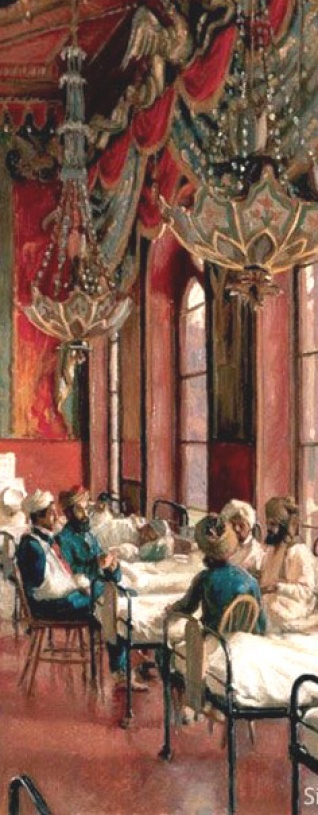History
Doctor Brighton's Pavilion
SANDEEP SINGH BRAR
What happens when you take wounded Sikh and other soldiers in World War I from the muddy trenches of France and put them in a former royal palace in England converted into a hospital?
sikhchic.com takes pleasure in announcing SikhMuseum.com's latest exhibit, "Doctor Brighton's Pavilion" which will provide you with all the answers ... and details of a crucial chapter in the saga of the Sikh heroes of the First World War.
At the start of World War I in the late autumn of 1914, one in every three soldiers under British command in France was part of the British Indian Army. The British military was ill prepared to deal with the casualties in some of the fiercest battles of the war as Sikh, Hindu and Muslim soldiers died and were wounded on the battlefields of France.
Ishar Singh's (Sikh, 59th Rifles) letter to a friend (50th Punjabis) in Gurmukhi:
Brighton, 1st May 1915
The battle is being carried on very bitterly. In the Lahore Division only 300 men are left. Some are dead, some wounded. The division is finished. Think of it -- in taking fifty yards of a German trench 50,000 men are killed. When we attack they direct a terrific fire on us -- thousands of men die daily. It looks as if not a single man can remain alive on either side -- then (when none is left) there will be peace. When the Germans attack they are killed in the same way. For us men it is a bad state of affairs here. Only those return from the battlefield who are slightly wounded. No one else is carried off. Even Sahibs are not lifted away. The battleground resounds with cries.
Needing to find hospitals for the wounded soldiers became a high priority, yet the possibility of housing wounded Indian soldiers in military hospitals with other ‘white’ British soldiers was considered out of the question. This was the time of the British Raj which was based on the cornerstone of ‘white supremacy’.
The racial and social hierarchy so carefully cultivated in the British Empire was firmly rooted in the belief that a separation between 'whites' and other races had to be maintained. Otherwise an over familiarity between the rulers and the ruled would subvert the relations underpinning imperial domination.
The British solution was creative and unprecedented. One of the most unique buildings in England, the Royal Pavilion in the seaside town of Brighton, as well as two other buildings in Brighton, were converted into hospitals for the Sikh and Indian soldiers.
The Royal Pavilion is unlike any other castle in England. Built for the Prince Regent, later King George IV, in stages between 1787 and 1823, it appears to have been designed as if for a children’s fairytale book. With palm-tree columns, Chinese dragons, exotic looking eastern minarets and domes it is hard to believe that it is real at all. A stunning work of architectural fancy that was rapidly converted into a hospital for wounded Sikh and Indian soldiers in late 1914.
The SikhMuseum.com exhibit features detailed painting and photographs of the Royal Pavilion’s interior and exterior as well as those of the adjoining Dome and Corn Exchange which once served as the Royal Riding Stables and which were also converted into hospital wards for the said soldiers.
Not only was the architecture of the hospital remarkable, but also the administration of the Brighton Hospitals. From restrictions on mixing with the Brighton townsfolk to the strange caste-based superstitions that led to 9 separate kitchens for different religions and castes and even two separate water supplies (one for Sikhs and Hindus and another one for Muslims), to the British fear of having ‘white women’ nurses in contact with Indian patients; the Brighton hospitals were unlike any other military or civilian hospital that has ever existed.
The SikhMuseum.com exhibit includes the discovery of a military relic belonging to a wounded Sikh soldier at Brighton that reveals a story of war and gratitude. An interactive virtual tour of a 1915 hospital ward at the Royal Pavilion. Rare archival photos and film footage, wartime paintings of the hospital and even short stories about the Royal Pavilion hospital written almost a century ago.
The Doctor Brighton’s Pavilion exhibit also includes an analysis of the entire ‘Brighton experiment’ and details of what the British initially regarded as an unplanned burden but which eventually became a political windfall that was used to enhance the prestige of the Raj and its legitimacy in India at a time of growing political instability.
Read the Maharaja of Patiala’s speech that he gave at the opening ceremonies of the Indian Memorial Gateway at the Royal Pavilion in 1921, in which he coined the term ‘Doctor Brighton’.
Honour and remember those Sikh and other soldiers who died and were cremated on the outskirts of Brighton at the location of the present day Chattri Memorial and learn about the almost forgotten Muslim Burial Ground.
To view the exhibit Doctor Brighton’s Pavilion, visit SikhMuseum.com.
SikhMuseum.com is dedicated to preserving a people’s heritage by providing a world-class online repository of the Sikh experience in the form of ground-breaking exhibits about various aspects of Sikh history.
The author is the Curator of SikhMuseum.com and the creator of the world’s first Sikh website, Sikhs.org
July 30, 2012




